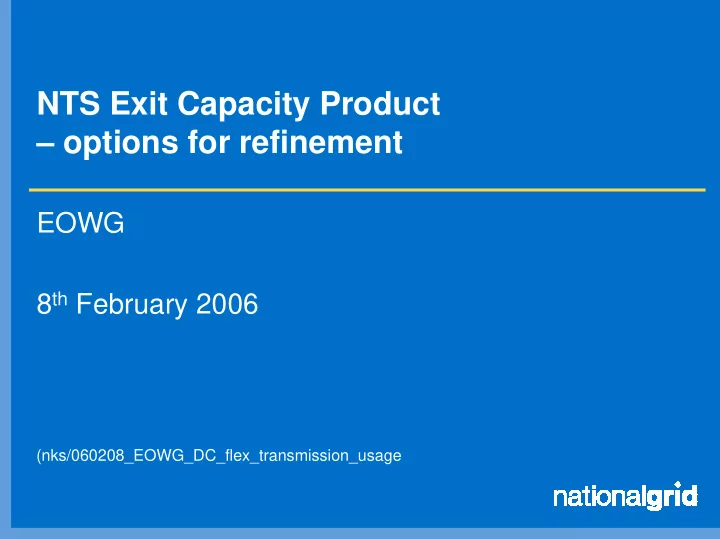

NTS Exit Capacity Product – options for refinement EOWG 8 th February 2006 (nks/060208_EOWG_DC_flex_transmission_usage
Background and presentation objective … this presentation builds on previous presentations given to the Enduring Offtakes Workgroup on 18 th January and 1 st February and the Transmission Workstream on 2 nd February … it provides some insight into DC flex/transmission utilisation
… the Enduring Offtake Working Group have asked for data about historic flexibility/throughput utilisation at other NTS exit points … whilst data is being gathered it might be worth thinking about some of the “theory” associated with transmission/flexibility feasible ranges
Thinking about transmission/flexibility substitutability (1) For DCs the current bundled NTS Exit Capacity Product enables access to any flow rates beneath the implied MHQ envelope DCs effectively have access to a maximum of 2/9 SOQ “flexibility” Offtake profile Flow rate 24*MHQ = SOQ MHQ 06:00 22:00 06:00 This maximum flex usage (2/9 of SOQ) occurs at 2/3 SOQ throughput
Thinking about transmission/flexibility substitutability (2) Maximum theoretical flexibility taken below SOQ can be easily established Offtake profile Flow rate 24*MHQ = SOQ MHQ x/3 x/3 x/3 Average flow rate x/3 x/3 06:00 22:00 06:00 Thus maximum flex usage is 2/3 of ( SOQ – actual daily offtake)
Thinking about transmission/flexibility substitutability (3) So the theoretical transmission/flexibility envelope associated with Direct Connects can be established from a number of considerations: Flexibility Slope of line = -2/3 utilisation SOQ Transmission throughput
Thinking about transmission/flexibility substitutability (4) At lower demand levels “flexibility utilisation” is also “capped” Offtake profile Flow rate Max flow Average 2/3 max flow rate flow rate 06:00 22:00 06:00 Flexibility utilisation = 1/3 throughput
Thinking about transmission/flexibility substitutability (5) So working along the throughput axis the max flexibility utilisation can be visualised as follows: Flexibility utilisation Slope of line = 1/3 SOQ Transmission throughput
Thinking about transmission/flexibility substitutability (6) So the upper emvelope of the theoretical transmission/flexibility envelope associated with Direct Connects can be visualised as follows: Flexibility utilisation 2/9 of SOQ 2/3 SOQ Transmission throughput SOQ
Thinking about transmission/flexibility substitutability (7) .. and the full envelope could be established as: Flexibility utilisation 2/9 of SOQ 2/3 SOQ Transmission throughput SOQ
Thinking about transmission/flexibility substitutability (8) .. but unfettered access to flexibility might not be possible: Flexibility utilisation 2/9 of SOQ Slope = ¼. 5 2/3 SOQ Transmission throughput SOQ
… some examples of DC transmission/flexibility utilisation
.. an industrial load, just a few days of material flex utilisation Direct Connect 1 (June 2005 to November 2005) Flow Flex Utilisation 0.00 0.00 Throughput Capacity Flex 4.5:1 line
Direct Connect 2 (June 2005 to November 2005) Flow Flex Utilisation 0.00 0.00 Throughput Capacity Flex 4.5 : 1 line
Direct Connect 3 (June 2005 to November 2005) Flow Flex Utilisation 0.00 0.00 0.50 1.00 1.50 2.00 2.50 3.00 3.50 4.00 4.50 Throughput Capacity Flex 4.5 : 1 line
Direct Connect 4 (June 2005 to November 2005) Flow Flex Utilisation 0.00 0.00 Throughput Capacity Flex 4.5 : 1 line
Next steps Does the Transmission Workstream see merit in further consideration of the pure TANIF model? the two product (expanding flexibility model) ? the single booking parameter derivative of the above? Alternatively are there other approaches that should be considered at this time?
Recommend
More recommend